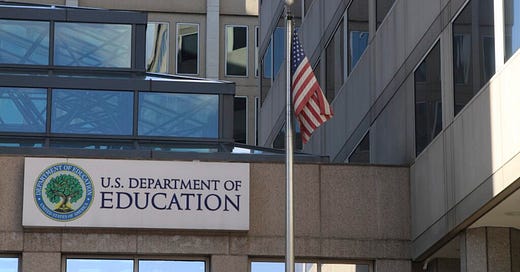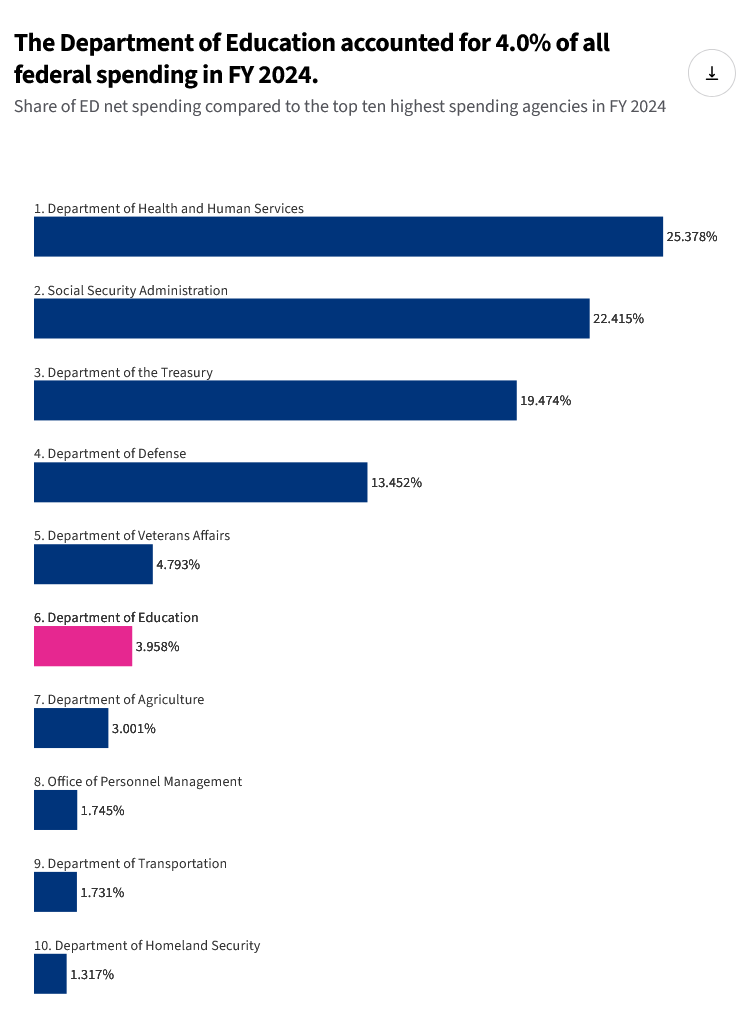Villegas | CLMI
President Trump was never the only critic of the Department of Education - he’s just been the most vocal one. Created by Congress in 1979 - and signed into law by then President Jimmy Carter - the central agency oversees academic criteria and performance, while also providing billions of dollars in support, to all schools (K-12 and post-secondary) throughout the nation. It went into operation in 1980 - during a presidential election and last year of Carter’s first term before he lost to Ronald Reagan. Since it’s creation, it’s long been a target for conservatives who’ve viewed it as an example of federal government waste and largesse. President Ronald Reagan also attempted to dismantle the Education Department, without much luck, in its first year.
This is the first time, however, that a president has not only aggressively placed the agency in his line of political fire (using it as electoral bait in the 2024 elections), but has also successfully taken major steps to completely deconstruct the department. The most recent move is the “reduction in force” notice just issued to more than 1,300 workers at the agency, as ABC news reports …
Over 1,300 federal employees impacted by the Department of Education's March 11 reduction in force received their official separation notices Thursday, according to copies reviewed by ABC News.
"It is with great regret that I must inform you that your position is being abolished and you have been reached for reduction in force (RIF) action," the notices read, in part.
The RIF was one of the first major steps in massively reducing the Education Department after President Donald Trump signed an executive order directing Secretary of Education Linda McMahon to close the agency on March 20.
Both Trump and McMahon have suggested they will continue reducing the size of the agency and return education power and decisions to the states.
The president has said that the RIF'd employees either weren't showing up to work or they weren't good at their jobs. But the notices explained that the separation is not based on performance evaluations -- it is due to the "reduction in the number of positions" at the agency. The notices also said that employees have the right to appeal this reduction.
All of this comes in the wake of the president’s false claims that the U.S. ranks 40th in education compared to other countries. Is that true, however?
Not exactly, according to global Organization for Economic Cooperation & Development’s Program for International Student Assessment data since 2022 …
The Program for International Student Assessment, for instance, measures 15-year-olds’ knowledge in the areas of reading, math and science. In the most recent results from 2022, the mean score for math among American teens ranked No. 21 among the approximately three dozen countries that were assessed and belonged to the Organization for Economic Cooperation and Development.
The U.S. ranked fifth in reading among OECD countries, and tied for No. 10 in science. (It’s worth noting, as PISA documents do, that because such scores are estimates derived from samples, precise rankings can be difficult to determine and are accompanied by a range. But America’s worst ranking within those ranges was never last.)
The U.S. also recently ranked No. 8 out of 41 countries in educational attainment, according to OECD data, with 92% of adults ages 25 to 64 having at least a high school degree – a share much higher than the OECD average of 79%.
Where the United States does rank low in that assessment is in Social and Gender Inequality …
Meanwhile, a January executive order Trump signed was for the education department to “prioritize school choice programs” noting that parents need “opportunities for students to attend the school that best fits their needs.” In a bold move, he sent out notices to 60 universities accusing the institutions of “racial preferences and stereotypes in education on programs and activities.” The department has then cut their workforce by 50 percent, as part of a patters of dramatic workforce reductions throughout the federal government.
But What Does The Education Department Do?
Lost in the fog of debate over the future of the agency, there is little public understanding as to what the Department of Education is exactly tasked to do. We do know that it distributes billions in student loans each year. It’s also a central source of federal funding for statewide education agencies, local school districts and charter school programs. In Fiscal Year 2024 …
From operating the free application for federal aid/FAFSA, which allows students to apply for loans, grants and other college aids, to collecting data on education student outcomes from early to higher education, to providing funding and food to help poor and disabled students enrolled in K-12 schools. It’s also tasked to ensure equal education through its office of civil rights. It does quite a bit for drawing only 4 percent of the overall federal budget of nearly $7 trillion.
And it ranks near the lowest in spending compared to other agencies …
What Does This All Mean
Arguably, the most central need or resource the Department of Education provides is the support function for low income, middle class and special needs students, with most in high poverty based in city school districts and the majority being Black, Hispanic and Indigenous/Alaskan ...
Cuts to the agency then translates into disassembling education as a whole, along with critical support systems for high poverty communities relying on a quality education as their best path towards success. The agency’s funding of schools and management of loans, along with tracking key education data, not only helps maintain the rather high ranking of United States education world compared to other countries, but it attempts to provide a massive academic system for more than 20 million students. A budgetary and staff shortfall could mean parents and students suffer the most. Districts that rely on federal funding will have to cut budgets or, worse, shut down schools and services. Students will have to drop out of college without the funding and necessary needs met. In another potential blow, special needs students will be faced with decreases in support at a time when they’ll need it the most.
DIAMOND VILLEGAS is a Fellow at the Civic Literacy & Media Influence Institute at Learn4Life








